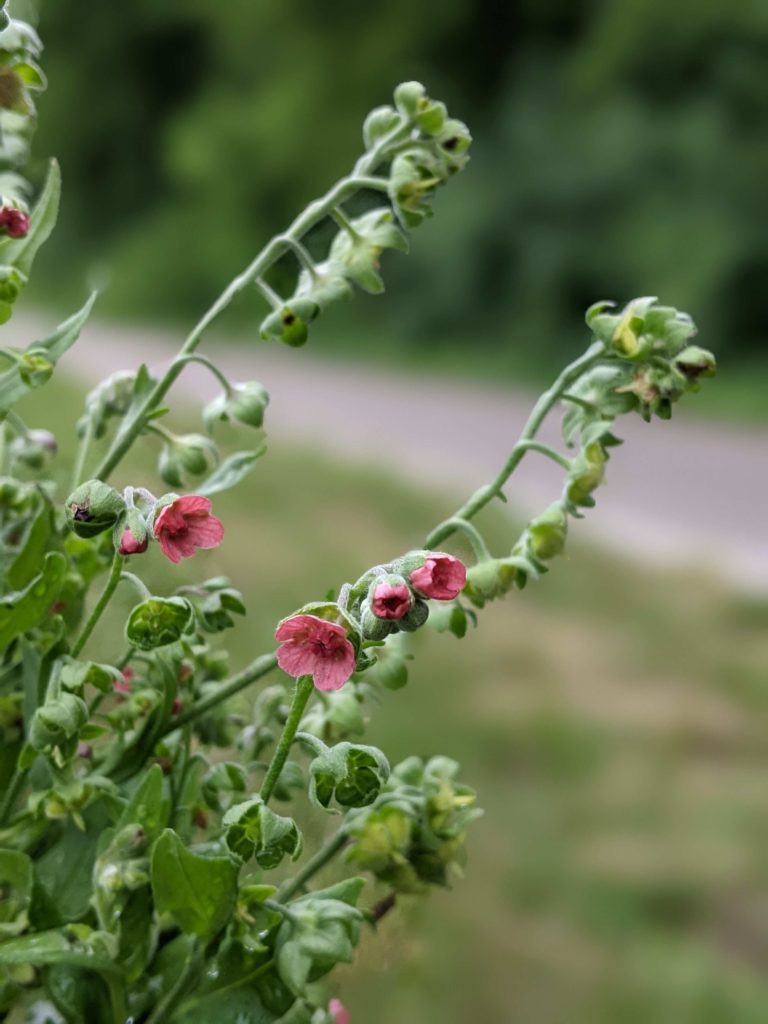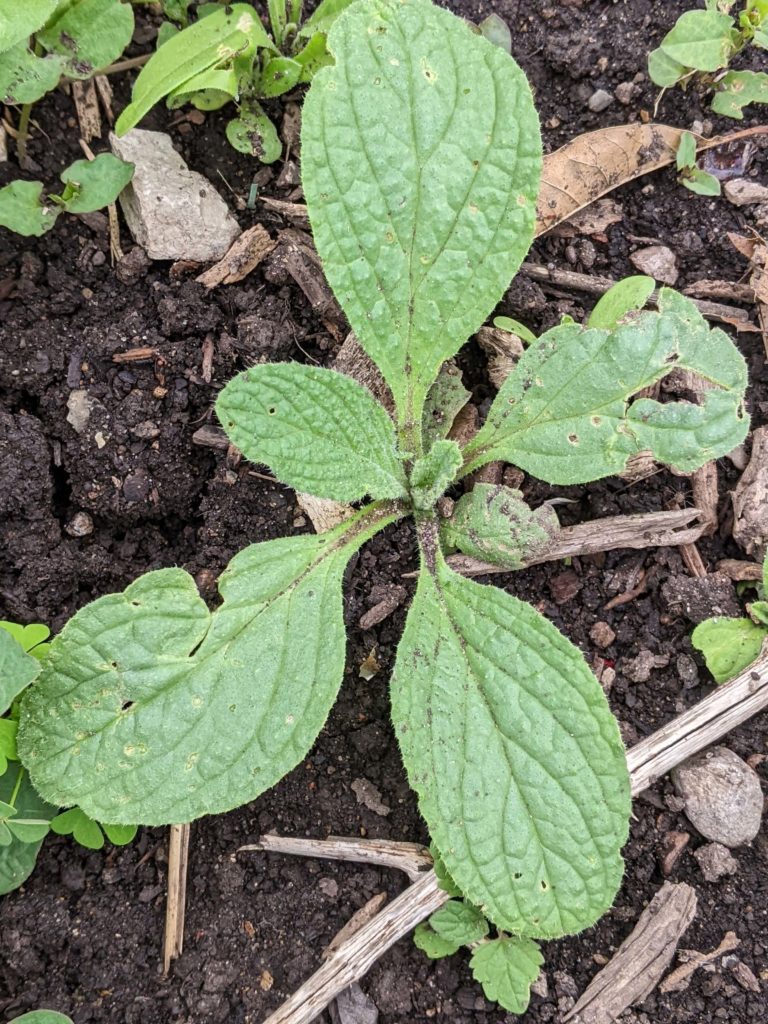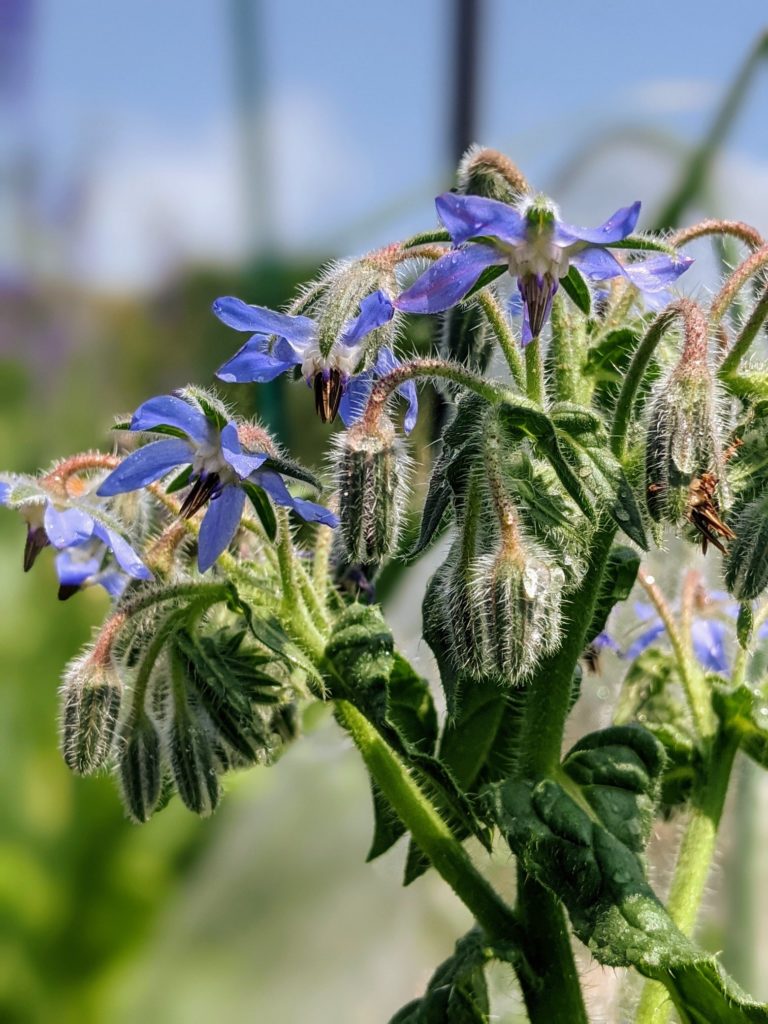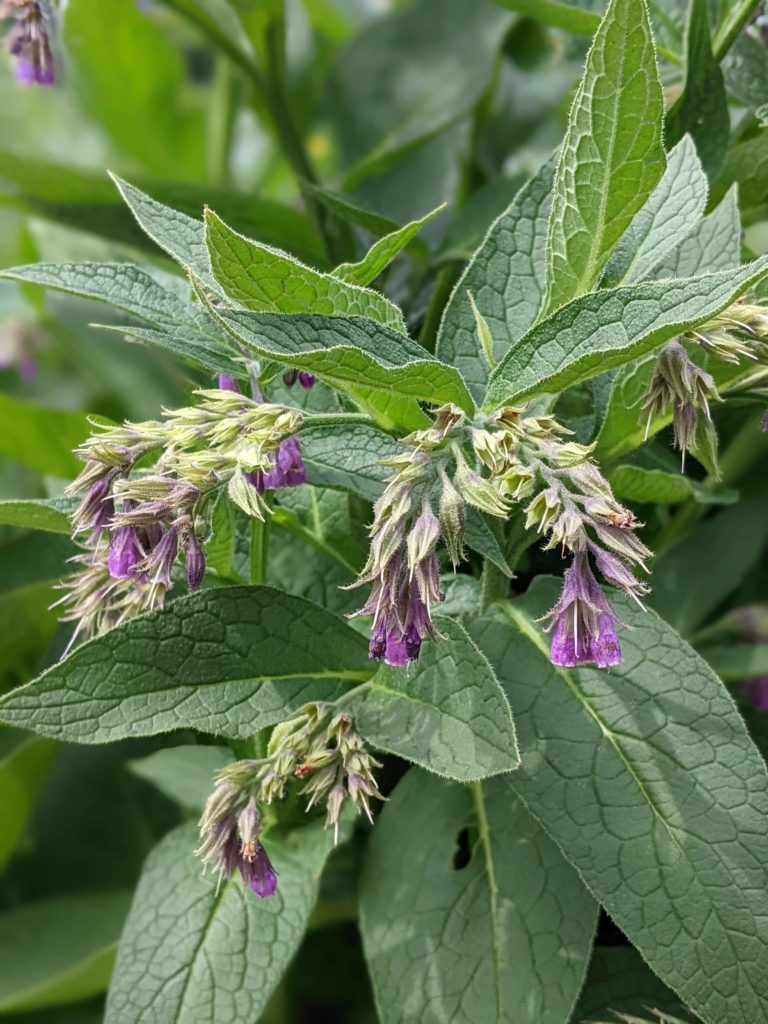Borage is an understated plant that has long appealed to me in the garden for its subtle, starry flower shape, attraction to bees, and ease of reseeding itself every year. Plus, it’s edible.
As it turns out, borage belongs to quite a large plant family of over 2,000 species, including forget me nots, comfrey, heliotropes, Virginia bluebells, and many others. They are characterized by hairy or bristly leaves and coiling flower stems that resemble scorpion tails.


Borage family plants are also characterized by the presence of pyrrolizidine alkaloids, which often make them poisonous to livestock and a source of debate about the potential toxicity of herbal applications like borage seed oil and comfrey. Some species cause contact dermatitis.


This family of plants reminds us that plants are not simply nice, cute things; they have evolved to battle the elements and predators!
Borage
Let’s start with borage, my personal entry point into this family. Borage or starflower (B. officinalis) is a very accessible yet underappreciated ornamental, medicinal, culinary, and oilseed plant.

For many years I appreciated borage solely for its subtle, beautiful, and bee-attracting small flowers. However, the young green leaves have many culinary uses. Care must be taken to eat the leaves when they are young, before they become large and bristly.


Borage culinary use is common in Germany (soups, green sauce or Grüne Soße), Spain (boiled and sauteed with garlic as a side dish or garnish), Italy (pasta fillings, e.g. for ravioli), and Poland and Russia (flavoring for pickles). Young stalks and leaves can be cooked and eaten as a vegetable. The leaves have a mild cucumber taste and are added to teas and salads. Eat Your Greens has more ideas for how to use this unique herb.

Historical sources associate borage with courage. Roman military leaders supposedly gave their troops borage-infused wine for extra bravery. Whether that bravery came from the wine or the borage seems questionable to me. In a rigorous scientific test, I drank some borage-infused wine, then some plain wine, but found no discernable differences in my courage levels.

Other Edible Plants
Borage isn’t the only edible plant in this vast family. People in Crete eat the young stems of garden anchusa (A. azurea) boiled, steamed, or fried. Common bugloss (Anchusa officinalis) was an edible wild herb for Arab people in the Levant, who boiled, chopped, and sauteed the young spring leaves with garlic and used this as a garnish for meat or eggs.
Leaves aren’t the only edibles. The fruits of Cordia species are known by many names and are eaten raw, cooked, and pickled. In Niger, the fruits of the grey-leaved saucer berry (Cordia sinensis) are cooked into a thick syrup used to sweeten porridge. Elsewhere, the fruits are dried or used to make juice and beer. Edible fruits of the closely related Ehretia genus are used in similar ways. For example, the peach bush (Ehretia saligna) was a traditional food source of aboriginal Australians.

Woodland Flowers & Ornamentals
Like the borage flower, many plants in this family have small, understated but beautiful flowers. Familiar woodland examples include Virginia bluebells, forget me nots, and others.
Virginia Bluebells
Virginia bluebells (Mertensia) are one of the first woodland flowers to emerge in spring in temperate climates. The flowers change color from pink to blue or white; this color change, a feature of the plant family, occurs due to an increase of pH in the flower.

Forget Me Nots

Forget me nots (Myositis spp.), another spring woodland flower, have strong cultural and historical symbolism, including as a Masonic emblem, Nazi Party emblem, and a remembrance symbol for wartime deaths (especially World War I), the Armenian Genocide, dementia, and Alzheimers.



Many other plants in this family go by the name forget me not, such as the great forget-me-not, alpine forget-me-nots, and the giant forget-me-not.
Waterleaf
Great waterleaf (Hydrophyllum appendiculatum) is common to the Midwest along with other waterleaf species like Virginia waterleaf (H. virginianum).

Heliotropes
Heliotropes (Heliotropium spp.) are so called because the flower heads turn themselves to follow the Sun (turning toward the Sun in Greek).

Pollinators
This family has a lot of pollinator-friendly flowers. Among all the flowers I grow in my garden, borage is in my top 5 for attracting bees. Plants in this family (especially buglosses) are used for nectar by honeybee keepers.

In some species, flowers change from red to blue as they age, possibly to signal to pollinators that the flower is old and not worth their time.

Medicinal & Folk Uses
Many medicinal uses have been recorded for this plant family, most notably for borage and comfrey. Several plants also have practical applications such as in natural dyes.
Borage
Borage has a host of medicinal uses including for gastrointestinal, respiratory, cardiovascular, and topical skin disorders. Most commercial cultivation is for borage seed oil, which has a particularly high amount of γ-linolenic acid and has been studied for its potential to treat inflammatory disorders, arthritis, and eczema. However, it is not yet clear whether the effects are valid. The oil also contains pyrrolizidine alkaloids which are toxic to the liver.
Comfrey
Likewise, comfrey is the center of much controversy. It is a favored remedy of modern herbalists but banned by the USDA for medicinal use due to the aforementioned toxicity issues.

| Comfrey Fertilizer Recipe Comfrey makes a great garden fertilizer. |
| 1. Fill a barrel or plastic garbage can 1/4 full with comfrey leaves 2. Weigh the leaves down with a stone or a brick 3. Fill the container with water 4. Put a lid on the container 5. Let stand for 4 to 6 weeks. The mixture is ready when the leaves have rotted and are no longer visible. 6. Your liquid feed is ready to use in your garden! 7. If your comfrey plants have grown enough you can start a new batch 8. Another method is to use comfrey leaves as above but without the addition of water. The result is a thick, black concentrate. This should be diluted at 15:1 before use. |
Other Medicinal Uses
Many other medicinal uses exist for this family, many of them in the form of poultices for burns and wounds. For example, the root of Arnebia densiflora, native to cliffs of Greece and Turkey, combined with olive oil or butter and beeswax to make an ointment that is applied to wounds and has been researched for its wound-healing properties.





Yerba santa is an important medicinal and symbolic plant for indigenous people in southwestern U.S. and Mexico. The name means “sacred herb” in Spanish.
Dye
Several plants in this family produce dye colors ranging from deep red brown to blue. Alkanet is a common name referring to several sources of dye; the word derives from the word for henna.


Unique Desert Plants
In closing, I highlight some of the more exotic plants in this family, such as the towering Echiums, desert-dwelling plants, and even parasitic plants.
Echium
Echium species comprise the most diverse and drought-tolerant perennial shrubs in their native North African, European, and Central Asian habitats. Their ornamental flower stalks lure bees and butterflies.
Endemic and endangered to the laurel forests of the Canary Islands, the giant viper’s bugloss (E. pininana) produces a tall spike of flowers only once before dying; each of the thousands of flowers produces four nutlets or seeds, resulting in hundreds of thousands of seeds that are dispersed by the wind.

Desert Dwellers
Other interest desert-dwelling plants include the crinklemats (Tiquilia spp.), fiddleleaf plants (Nama spp.), and Phacelia.


The fiddleleaf plants (Nama spp.) are hairy plants in sandy desert habitats.

Several Phacelia grow in deserts, such as the desert bluebells (Phacelia campanularia).

Parasitic Plants
Rounding off the oddities of this plant family are five species of parasitic plants. They are succulent but lack chlorophyll and thus cannot photosynthesize their own food, so they act as parasites on the roots of other plants.


